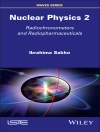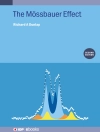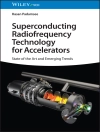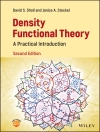Charge and Energy Transfer Dynamics in Molecular Systems
Comprehensive resource offering knowledge on charge and energy transfer dynamics in molecular systems and nanostructures
Charge and Energy Transfer Dynamics in Molecular Systems provides a unified description of different charge and energy transfer phenomena in molecular systems with emphasis on the theory, bridging the regimes of coherent and dissipative dynamics and thus presenting classic rate theories as well as modern treatments of ultrafast phenomena. Starting from microscopic models, the common features of the different transfer processes are highlighted, along with applications ranging from vibrational energy flow in large polyatomic molecules, the motion of protons in solution, up to the concerted dynamics of electronic and nuclear degrees of freedom in molecules and molecular aggregates.
The newly revised and updated Fourth Edition contains a more detailed coverage of recent developments in density matrix theory, mixed quantum-classical methods for dynamics simulations, and a substantially expanded treatment of time-resolved spectroscopy.
The book is written in an easy-to-follow style, including detailed mathematical derivations, thus making even complex concepts understandable and applicable.
Charge and Energy Transfer Dynamics in Molecular Systems includes information on:
- Electronic and vibrational molecular states, covering molecular Schrödinger equation, Born—Oppenheimer separation and approximation, Hartree-Fock equations and other electronic structure methods
- Dynamics of isolated and open quantum systems, covering multidimensional wave packet dynamics, and different variants of density operator equations
- Interaction of molecular systems with radiation fields, covering linear and nonlinear optical response using the correlation function approach
- Intramolecular electronic transitions, covering optical transition and internal conversion processes
- Transfer processes of electrons, protons, and electronic excitation energy
Providing in-depth coverage of the subject, Charge and Energy Transfer Dynamics in Molecular Systems is an essential resource for anyone working on timely problems of energy and charge transfer in physics, chemistry and biophysics as well as for all engaged in nanoscience and organic electronics.
İçerik tablosu
Preface to the Fourth Edition xiii
Preface to the Third Edition xv
Preface to the Second Edition xvii
Preface to the First Edition xix
1 Introduction 1
2 Electronic and Vibrational Molecular States 7
2.1 Introduction 7
2.2 Molecular Schrödinger Equation 9
2.3 Born–Oppenheimer Separation 11
2.3.1 Born–Oppenheimer Approximation 13
2.4 Electronic Structure Methods 15
2.4.1 The Hartree–Fock Equations 17
2.4.2 Density Functional Theory 19
2.5 Potential Energy Surfaces 21
2.5.1 Harmonic Approximation and Normal Mode Analysis 24
2.5.2 Operator Representation of the Normal Mode Hamiltonian 27
2.5.3 Construction of System–Bath Models 31
2.6 Adiabatic versus Diabatic Representation of the Molecular Hamiltonian 36
2.6.1 Adiabatic Picture 36
2.6.2 Diabatic Picture 37
2.6.3 Two-State Case 40
2.7 Condensed-phase Approaches 42
2.7.1 Dielectric Continuum Model 43
2.7.1.1 Medium Electrostatics 43
2.7.1.2 Reaction Field Model 47
2.7.2 Explicit Quantum-classical Solvent Model 49
2.8 Supplement 51
2.8.1 Franck–Condon Factors 51
2.8.2 The Two-level System 52
2.8.3 The Linear Molecular Chain and the Molecular Ring 55
References 57
Further Reading 57
3 Dynamics of Isolated and Open Quantum Systems 59
3.1 Introduction 60
3.2 Time-dependent Schrödinger Equation 66
3.2.1 Wave Packets 66
3.2.2 The Interaction Representation 69
3.2.3 Multidimensional Wave Packet Dynamics 71
3.3 The Golden Rule of Quantum Mechanics 75
3.3.1 Transition from a Single State into a Continuum 75
3.3.2 Transition Rate for a Thermal Ensemble 78
3.3.3 Green’s Function Approach 81
3.4 The Nonequilibrium Statistical Operator and the Density Matrix 84
3.4.1 The Density Operator 84
3.4.2 The Density Matrix 86
3.4.3 Equation of Motion for the Density Operator 88
3.4.4 Wigner Representation of the Density Operator 90
3.4.5 Dynamics of Coupled Multilevel Systems in a Heat Bath 93
3.5 The Reduced Density Operator and the Reduced Density Matrix 96
3.5.1 The Reduced Density Operator 96
3.5.2 Equation of Motion for the Reduced Density Operator 97
3.5.3 Mean-field Approximation 98
3.5.4 The Interaction Representation of the Reduced Density Operator 99
3.5.5 The Nakajima–Zwanzig Equation 101
3.5.6 Second-order Equation of Motion for the Reduced Density Operator 105
3.6 Quantum Master Equation 107
3.6.1 Markov Approximation 109
3.7 The Reservoir Correlation Function 112
3.7.1 General Properties of C uv (t) 112
3.7.2 Harmonic Oscillator Reservoir 114
3.7.3 The Spectral Density 116
3.7.4 Linear Response Theory for the Reservoir 120
3.7.5 Classical Description of C uv (t) 122
3.8 Reduced Density Matrix in Energy Representation 123
3.8.1 The Quantum Master Equation in Energy Representation 123
3.8.2 Multilevel Redfield Equations 126
3.8.2.1 Population Transfer: a = b, c = d 127
3.8.2.2 Coherence Dephasing: a ≠ b, a = c, b = d 129
3.8.2.3 Remaining Elements of R ab, cd 129
3.8.3 The Secular Approximation 130
3.8.4 State Expansion of the System–Reservoir Coupling 131
3.8.4.1 Some Estimates 132
3.9 Coordinate and Wigner Representation of the Reduced Density Matrix 133
3.10 The Path Integral Representation of the Density Matrix 135
3.11 Hierarchy Equations of Motion Approach 140
3.12 Coherent to Dissipative Dynamics of a Two-level System 143
3.12.1 Coherent Dynamics 143
3.12.2 Dissipative Dynamics Using Eigenstates 144
3.12.3 Dissipative Dynamics Using Zeroth-order States 147
3.13 Trajectory-based Methods 149
3.13.1 The Mean-field Approach 149
3.13.2 The Surface Hopping Method 152
3.14 Generalized Rate Equations: The Liouville Space Approach 155
3.14.1 Projection Operator Technique 156
3.14.2 Generalized Rate Equations 157
3.14.3 Rate Equations 159
3.14.4 The Memory Kernels 159
3.14.5 Second-order Rate Expressions 161
3.14.6 Fourth-order Rate Expressions 164
3.14.6.1 Three-level System with Sequential Coupling 165
3.15 Supplement 168
3.15.1 Thermofield Dynamics 168
3.15.2 Stochastic Schrödinger Equation 172
References 175
Further Reading 176
4 Interaction of Molecular Systems with Radiation Fields 177
4.1 Introduction 178
4.2 Absorption of Light 182
4.2.1 Linear Absorption Coefficient 182
4.2.2 Dipole–Dipole Correlation Function 184
4.3 Nonlinear Optical Response 186
4.3.1 Nonlinear Polarization 186
4.3.2 Nonlinear Response Functions 189
4.3.3 Eigenstate Expansion of the Response Functions 191
4.3.4 Cumulant Expansion of the Response Functions 194
4.3.5 Rotating Wave Approximation 197
4.3.6 Pump–Probe Spectroscopy 198
4.3.7 Two-dimensional Spectroscopy 202
4.4 Field Quantization and Spontaneous Emission of Light 206
References 208
Further Reading 209
5 Vibrational Dynamics: Energy Redistribution, Relaxation, and Dephasing 211
5.1 Introduction 211
5.2 Intramolecular Vibrational Energy Redistribution 215
5.2.1 Zeroth-order Basis and State Mixing 215
5.2.2 Golden Rule and Beyond 219
5.3 Intermolecular Vibrational Energy Relaxation 223
5.3.1 The System–Reservoir Hamiltonian 223
5.3.2 Instantaneous Normal Modes 226
5.3.3 Generalized Langevin Equation 228
5.3.4 Classical Force–Force Correlation Functions 231
5.3.5 Dissipative Dynamics of a Harmonic Oscillator 234
5.4 Polyatomic Molecules in Solution 237
5.4.1 System–Reservoir Hamiltonian 237
5.4.2 Higher Order Multiquantum Relaxation 238
5.5 Quantum–Classical Approaches to Relaxation and Dephasing 243
References 247
Further Reading 247
6 Intramolecular Electronic Transitions 249
6.1 Introduction 249
6.1.1 Optical Transitions 250
6.1.2 Internal Conversion Processes 255
6.2 The Optical Absorption Coefficient 255
6.2.1 Golden Rule Formulation 255
6.2.2 The Density of States 258
6.2.3 Absorption Coefficient for Harmonic Potential Energy Surfaces 260
6.2.4 Absorption Lineshape and Spectral Density 263
6.2.5 Cumulant Expansion of the Absorption Coefficient 264
6.2.6 Absorption Coefficient for Model Spectral Densities 266
6.3 Absorption Coefficient and Dipole–Dipole Correlation Function 269
6.3.1 Absorption Coefficient and Wave Packet Propagation 269
6.3.2 Absorption Coefficient and Reduced Density Operator Propagation 273
6.3.3 Mixed Quantum–Classical Computation of the Absorption Coefficient 275
6.4 The Emission Spectrum 280
6.5 Optical Preparation of an Excited Electronic State 281
6.5.1 Wave Function Formulation 281
6.5.1.1 Case of Short Pulse Duration 284
6.5.1.2 Case of Long Pulse Duration 284
6.5.2 Density Matrix Formulation 284
6.6 Internal Conversion Dynamics 286
6.6.1 The Internal Conversion Rate 287
6.6.2 Ultrafast Internal Conversion 288
6.7 Supplement 290
6.7.1 Absorption Coefficient for Displaced Harmonic Oscillators 290
References 294
Further Reading 294
7 Electron Transfer 295
7.1 Classification of Electron Transfer Reactions 295
7.2 Theoretical Models for Electron Transfer Systems 305
7.2.1 The Electron Transfer Hamiltonian 305
7.2.2 The Electron–Vibrational Hamiltonian of a Donor–Acceptor Complex 310
7.2.2.1 The Spin-Boson Model 312
7.2.2.2 Two Independent Sets of Vibrational Coordinates 313
7.2.3 Electron–Vibrational State Representation of the Hamiltonian 314
7.3 Regimes of Electron Transfer 315
7.3.1 Landau–Zener Theory of Electron Transfer 319
7.4 Nonadiabatic Electron Transfer in a Donor–Acceptor Complex 323
7.4.1 High-temperature Case 323
7.4.2 High-temperature Case: Two Independent Sets of Vibrational Coordinates 327
7.4.3 Low-temperature Case: Nuclear Tunneling 330
7.4.4 The Mixed Quantum–Classical Case 333
7.4.5 Description of the Mixed Quantum–Classical Case by a Spectral Density 335
7.5 Bridge-Mediated Electron Transfer 336
7.5.1 The Superexchange Mechanism 338
7.5.2 Electron Transfer Through Arbitrary Large Bridges 340
7.5.2.1 Case of Small Intrabridge Transfer Integrals 340
7.5.2.2 Case of Large Intrabridge Transfer Integrals 341
7.6 Nonequilibrium Quantum Statistical Description of Electron Transfer 343
7.6.1 Unified Description of Electron Transfer in a Donor–Bridge–Acceptor System 344
7.6.2 Transition to the Adiabatic Electron Transfer 347
7.7 Heterogeneous Electron Transfer 347
7.7.1 Nonadiabatic Charge Injection into the Solid State Described in a Single-Electron Model 348
7.7.1.1 Low-temperature Case 351
7.7.1.2 High-temperature Case 352
7.7.1.3 HET-induced Lifetime 352
7.7.2 Ultrafast Photoinduced HET from a Molecule into a Semiconductor. A Case Study 354
7.7.3 Nonadiabatic Electron Transfer from the Solid State into the Molecule 355
7.8 Charge Transmission Through Single Molecules 356
7.8.1 Inelastic Charge Transmission 359
7.8.1.1 An Example 360
7.8.2 Elastic Charge Transmission 361
7.8.2.1 An Example 364
7.8.2.2 Inclusion of Vibrational Levels 365
7.9 Photoinduced Ultrafast Electron Transfer 367
7.9.1 Quantum Master Equation for Electron Transfer Reactions 372
7.9.2 Rate Expressions 377
7.10 Supplement 378
7.10.1 Landau–Zener Transition Amplitude 378
7.10.2 The Multimode Marcus Formula 379
7.10.3 Second-order Electron Transfer Rate 380
7.10.4 Fourth-order Donor–Acceptor Transition Rate 382
7.10.5 Rate of Elastic Charge Transmission Through a Single Molecule 385
References 387
Further Reading 388
8 Proton Transfer 389
8.1 Introduction 389
8.2 Proton Transfer Hamiltonian 395
8.2.1 Hydrogen Bonds 395
8.2.2 Reaction Surface Hamiltonian for Intramolecular Proton Transfer 399
8.2.3 Tunneling Splittings 400
8.2.4 The Proton Transfer Hamiltonian in the Condensed Phase 404
8.2.4.1 Adiabatic Representation 405
8.2.4.2 Diabatic Representation 406
8.3 Adiabatic Proton Transfer 407
8.4 Nonadiabatic Proton Transfer 410
8.5 The Intermediate Regime: From Quantum to Quantum–Classical Hybrid Methods 412
8.5.1 Multidimensional Wave Packet Dynamics 413
8.5.2 Surface Hopping 415
8.6 Proton-coupled Electron Transfer 417
References 419
Further Reading 419
9 Excitation Energy Transfer 421
9.1 Introduction 421
9.2 The Aggregate Hamiltonian 427
9.2.1 The Intermolecular Coulomb Interaction 430
9.2.1.1 Dipole–Dipole Coupling 432
9.2.2 The Two-level Model 433
9.2.2.1 Classification of the Coulomb Interactions 433
9.2.3 Single and Double Excitations of the Aggregate 436
9.2.3.1 The Ground State Matrix Element 438
9.2.3.2 The Single Excited State Matrix Elements 438
9.2.3.3 The Double Excited State Matrix Elements 439
9.2.3.4 Off-Diagonal Matrix Elements and Coupling to the Radiation Field 440
9.2.3.5 Neglect of Intermolecular Electrostatic Coupling 441
9.2.4 Introduction of Delocalized Exciton States 441
9.2.4.1 The Molecular Heterodimer 443
9.2.4.2 The Finite Molecular Chain and the Molecular Ring 443
9.3 Exciton–Vibrational Interaction 444
9.3.1 Exclusive Coupling to Intramolecular Vibrations 445
9.3.2 Coupling to Aggregate Normal Mode Vibrations 448
9.3.3 Differentiating Between Intramolecular and Reservoir Normal Mode Vibrations 449
9.3.4 Exciton–Vibrational Hamiltonian and Excitonic Potential Energy Surfaces 449
9.4 Regimes of Excitation Energy Transfer 450
9.4.1 Quantum Statistical Approaches to Excitation Energy Transfer 452
9.5 Transfer Dynamics in the Case of Weak Excitonic Coupling: Förster Theory 453
9.5.1 The Transfer Rate 454
9.5.2 The Förster Rate 456
9.5.3 Nonequilibrium Quantum Statistical Description of Förster Transfer 458
9.5.3.1 Case of Common Vibrational Coordinates 462
9.5.3.2 Case of Vibrational Modulation of the Excitonic Coupling 464
9.6 Transfer Dynamics in the Case of Strong Excitonic Coupling 465
9.6.1 Rate Equations for Exciton Dynamics 465
9.6.2 Density Matrix Equations for Exciton Dynamics 466
9.6.3 Site Representation 468
9.6.4 Excitation Energy Transfer Among Different Aggregates 471
9.6.5 Exciton Transfer in the Case of Strong Exciton–Vibrational Coupling 472
9.6.6 Nonperturbative and Non-Markovian Exciton Dynamics 475
9.7 Optical Properties of Aggregates 477
9.7.1 Case of No Exciton–Vibrational Coupling 479
9.7.1.1 Static Disorder 481
9.7.2 Inclusion of Exciton–Vibrational Coupling 484
9.7.2.1 The n-Particle Expansion 484
9.7.2.2 Weak Exciton–Vibrational Coupling 487
9.7.2.3 Strong Exciton–Vibrational Coupling 488
9.8 Excitation Energy Transfer Including Charge-transfer States 490
9.8.1 Excitation Energy Transfer Via Two-electron Exchange 490
9.8.2 Charge-transfer Excitons and Charge Separation 493
9.9 Exciton–Exciton Annihilation 496
9.9.1 Three-level Description of the Molecules in the Aggregate 498
9.9.2 The Rate of Exciton–Exciton Annihilation 499
9.10 Supplement 500
9.10.1 Second Quantization Notation of the Aggregate Hamiltonian 500
9.10.2 Photon-mediated Long-range Excitation Energy Transfer 501
9.10.2.1 Preparatory Considerations for the Rate Computation 503
9.10.2.2 Photon Correlation Functions 505
9.10.2.3 The Rate of Photon-mediated Excitation Energy Transfer 506
9.10.2.4 Some Estimates 508
9.10.3 Fourth-order Rate of Two-electron-transfer-assisted EET 509
References 513
Further Reading 514
Index 515
Yazar hakkında
Volkhard May studied physics at Humboldt University, Berlin, and received his Ph.D. in Theoretical Physics in 1981, and his Habilitation at the College of Education, Güstrow, in 1987. His research activities focused on the theory of transfer phenomena in molecular nanostructures. He is retired since 2019.
Oliver Kühn received his Ph D from Humboldt University, Berlin. Since 2008 he is a Professor of Theoretical Physics at the University of Rostock. His current research focusses on dynamics of condensed phase systems such as molecular aggregates and novel materials.












